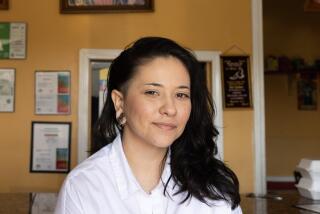Lutherans Invigorated by Outreach, Growing Change
- Share via
If you listen to humorist Garrison Keillor’s weekly tales from Lake Wobegon, a staple of his long-running radio show, “A Prairie Home Companion,” you know all about Lutherans: those pale, stoic Midwestern Scandinavian Americans not given to outward displays of emotion but with a propensity for potluck suppers featuring tuna noodle casserole and Jell-O with cottage cheese.
But Bishop H. George Anderson, who has led the nation’s largest body of Lutherans for the past five years, said that more and more, the joke is on Keillor.
For one thing, Lutherans are not all Midwesterners, he said--there’s a large contingent in Pennsylvania, for example. And although about 97% are white, there are signs of growing diversity.
“The fastest-growing elements within our church are the Hispanic and Asian population. Our Northern European component is decreasing,” said Anderson, who stopped in Baltimore this month to preside over the installation of Bishop Henry Gerard Knoche of the church’s 96,000-member Delaware-Maryland Synod. It’s a trend that’s affecting even Lutheran joke-telling, he said.
“It’s no longer possible at a Churchwide Assembly, for example, to talk just about Scandinavian humor because we have so many other traditions represented as well,” he said. “I think we are trying to adapt to and be welcoming to other kinds of worship traditions than the Bach and stained glass of the past.”
Reaching Out
to Other Churches
Anderson, a native of Los Angeles and historian by training who served as president of a seminary in South Carolina and a college in Iowa, will retire after next year’s Churchwide Assembly, a meeting held every two years to set policy for the 5.2-million-member Evangelical Lutheran Church in America.
The Evangelical Lutheran Church was formed in 1987--the result of a merger of the Lutheran Church in America, the American Lutheran Church and the Assn. of Evangelical Lutheran Churches--making it the sixth-largest Christian denomination in the country. Anderson is the second presiding bishop of the merged body.
During Anderson’s tenure, the Evangelical Lutheran Church has embarked on an extraordinary outreach to other Christian churches. Efforts at dialogue have resulted in agreements for “full communion” between his church and the Moravian, the Reformed Church in America, the Presbyterian Church (USA), the United Church of Christ and the Episcopal Church USA. Communion does not mean the churches are merging, but acknowledging that doctrinal differences between two denominations need not completely divide them.
Anderson’s most difficult task in this area was shepherding the agreement between Lutherans and Episcopalians, which was approved at last year’s Churchwide Assembly and will go into effect in January. Some church members were leery of accepting the Episcopal tradition of the “historic episcopate,” tracing the lineage of bishops in an unbroken line to the early church. To them, this smacked of a triumphalism and a church aristocracy that their founder, Martin Luther, had rejected in the Reformation.
With his genteel manner, Anderson was able to soothe the fears of enough church members for its passage.
“There are many people who think it will have a lot of damaging effects,” he said . “But my view is that . . . the idea that we will somehow become a much more hierarchical church doesn’t understand either the way the Episcopal Church works or our own tradition and our own ability to maintain the way we have governed ourselves.”
Churches Have
‘Common Mission’
Beyond those milestones, the Lutheran World Federation and the Roman Catholic Church last year signed an agreement on the theological argument on salvation--justification by faith vs. the importance of works--that started the Reformation, the 16th-century movement in Western Europe that resulted in the establishment of the Protestant churches.
Anderson said he believes it is the challenges of modern society that are bringing Christian churches together in a common mission.
Full-communion agreements mean denominations can share clergy; for example, now a Lutheran church without a pastor could call an Episcopal priest to serve, and vice versa. But full communion does not mean merger. Nor is that the goal, Anderson said.
In recent years, mainline Protestant churches have faced some hard times, with declining numbers and seemingly declining influence in society as the religious right has taken up the banner of gospel activism. Anderson’s message to his church: Be not afraid.
“I think I’ve convinced our church that it is a good time to be in the church, not a bad time,” Anderson said. “I’ve tried to emphasize the fact that the image of church as a kind of frosting that floats on the top of the wedding cake and is a kind of crown of society is not the New Testament image . . . to be a church that’s in struggle in society and that’s a missional church in society is.”
A healthy church, he said, is not one that is fat and satisfied, but one forced to exercise and struggle. “I’ve worked at helping our church to see this is an opportunity for us to understand fully what it is to rely on God in times that are difficult,” he said.
Otherwise, he says, the risk is becoming too comfortable. A church that does that, he says, “loses its connection, its dependence on God and becomes essentially another corporation.
More to Read
Sign up for Essential California
The most important California stories and recommendations in your inbox every morning.
You may occasionally receive promotional content from the Los Angeles Times.













